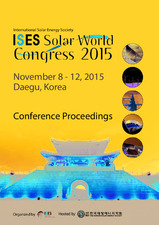| dc.description.abstract | High-rise residential building in Korea is distinctive. Urbanization level and city dwelling ratio are the nearly same even though the national land in Korea is 140 times larger than Singapore. Above all, three-fourth of the number of total multi-family housing is above ten stories building. This signifies that today a half of Korean lives in high-rise residential building like apartment. Above all, giant residential areas in cities require huge energy to support residents’ lifestyle. In this respect, solar systems are one of effective solutions for urban residential buildings. Thus, as a fundamental approach, this paper studies solar potential in high-rise residential buildings in Korea. High-rise residential building is generally unfavorable for solar energy. That is because, it is impossible to avoid diverse interferences from other urban factors. Therefore, high-rise residential building is required advanced strategies to maximize solar potential in order to set up renewable system in the near future. This study analyzed typical multi-family housing types and did a case study in the complex level to find the effective ways to solar energy. This result can be utilized for architect and engineers to refer to this study in their design to build low energy building. | en |


